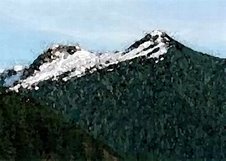Standing at the circulation desk, across hall from the Tongass Historical Museum, we have noticed that the most popular exhibits amongst the locals are the ones featuring historic photos of Ketchikan. There is something very compelling about studying the way familiar places used to look. Our new book Historic Photos of Alaska is a great example of this.
Selected and narrated by Fairbanks historian Dermot Cole, this book is a wonderful look back at the way Alaska has changed over the past century (there are a few earlier photos - including one of the Ketchikan waterfront in 1899, but the majority of Alaska's photographic record originated after we became a U.S. Territory in 1912). Published in time for Alaska's 50th anniversary of statehood, this is a good historical overview for both new residents and visitors to the Last Frontier and a valuable refresher to those of us who may have forgotten what we learned in school.
One of the things I found most interesting was the geographical ebb and flow of the photos. Most of the images in the first chapter ("The Alaska Purchase, 1867-1905") are of Southeast. The next chapter features a lot more photos of Interior Alaska, especially the mining hotspot of Nome. The section on the Depression is the most wide-ranging, looking at how all the areas of Alaska fared during the uncertain economy. The last part of the book goes from World War II to the completion of the Alaska Pipeline, and focuses mainly on Interior Alaska (the rail belt). I think this geographic progression in the photographs echoes the shift in economic and political power in the state. The only photo in this last chapter that features Southeast is of a group of tourists visiting the abandoned Kennecott Mine site.
How symbolic.
Friday, June 26, 2009
Subscribe to:
Post Comments (Atom)

No comments:
Post a Comment